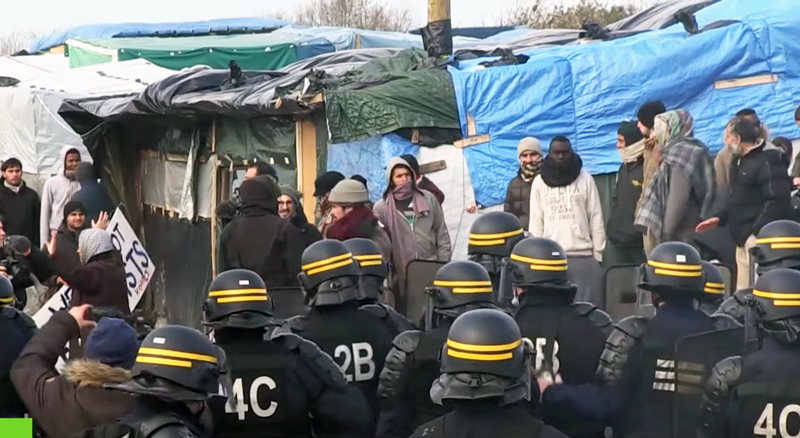France: ‘The Jungle’ Migrant Camp/”Plan will proliferate a multitude of mini-Calais throughout the country.”
Soeren Kern/ Gatestone Institute//September 30/16
In 2001 alone, 54,000 people “attacked” the Channel Tunnel terminal in Calais and 5,000 had gotten through.
Migrants evicted from Calais moved to Paris and established a massive squatter camp at the Jardins d’Eole, a public park near the Gare du Nord station, from where high-speed Eurostar trains travel to and arrive from London. The area has become a magnet for human traffickers who charge migrants thousands of euros for fake travel documents, for passage to London.
The President of the Alpes-Maritimes region, Eric Ciotti, criticized the government’s “irresponsible” plan to relocate migrants in Calais to other parts of France. He said the plan would “proliferate a multitude of small Calais, genuine areas of lawlessness that exacerbate lasting tensions throughout the country.”
A whistleblower reported that volunteer aid workers at “The Jungle” were forging sexual relationships with migrants, including children. “Female volunteers having sex enforces the view (that many have) that volunteers are here for sex,” he said.
French President François Hollande has vowed “definitively, entirely and rapidly” to dismantle “The Jungle,” a squalid migrant camp in the northern port town of Calais, by the end of this year.
Hollande made the announcement during a September 26 visit to Calais — but not to the camp itself — amid growing unease over France’s escalating migrant crisis, which has become a central issue in the country’s presidential campaign.
The French government plans to relocate the migrants at the camp to so-called reception centers in other parts of the country. But it remains unclear how the government will prevent migrants from returning to Calais.
Sceptics say the plan to demolish “The Jungle” is a publicity stunt that will temporarily displace the migrants but will not resolve the underlying problem — that French officials refuse either to deport illegal migrants or else to secure the country’s borders to prevent illegal migrants from entering France in the first place.
The decision to demolish the camp came just days after construction work began on a wall in Calais, a major transport hub on the edge of the English Channel, to prevent migrants at the camp from stowing away on cars, trucks, ferries and trains bound for Britain.
In recent months, people-smugglers armed with knives, bats and tire irons have forced truck drivers to stop so that migrants can board their vehicles. The Deputy Mayor of Calais, Philippe Mignonet, has described the main route to the port as a “no-go area” between midnight and 6am.
“The Jungle” — the name “jungle” comes from “dzhangal,” the Pashto word for forest — now houses around 10,000 migrants from Africa, Asia and the Middle East who are trying to reach Britain. Migrants at the camp are from Sudan (45%), Afghanistan (30%), Pakistan (7%), Eritrea (6%) and Syria (1%), according to aid agencies. The migrants at the camp are mostly young men and boys, including some 800 unaccompanied minors, who are seeking jobs in Britain’s underground economy.
Migrants have been gathering in Calais in large numbers ever since the Channel Tunnel linking France and Britain opened in May 1994, and the Schengen Agreement, which abolished border controls between France and most of its neighbors (but not the UK), entered into force in March 1995.
In 1999, the French government asked the Red Cross to build a migrant “reception center” in Sangatte to accommodate a growing number of migrants on the streets of Calais and surrounding areas. The Sangatte camp, which was housed in a giant warehouse situated about a half mile from the entrance to the Channel Tunnel, had a capacity of 600 people.
Far from resolving the migrant problem in Calais, the Sangatte facility served as a magnet, quickly drawing thousands more people to the area. Within months, some 2,000 migrants were living in the camp in increasingly cramped conditions. Many of those staying at Sangatte tried to jump onto slow-moving trains at the entrance to the Channel Tunnel, or hide inside trucks crossing to Britain on ferries.
At the time, French authorities reported a massive increase in the number of arrests in or around the Channel Tunnel. In 1999, 8,000 people were arrested in Calais for immigration offenses. By 2001, that number had jumped ten-fold to 80,000 arrests. Eurotunnel, the company that manages and operates the Channel Tunnel, said that in 2001 alone, 54,000 people had “attacked” the terminal in Calais and 5,000 had gotten through. Many of those were living in Sangatte.
The Sangatte camp was closed in late 2002, after a series of riots between Afghan and Kurdish migrants. In all, some 67,000 migrants stayed at the facility during its three years in operation.
In February 2003, France and Britain signed the Treaty of Le Touquet, which allows for so-called juxtaposed controls, meaning that travelers between the two countries now clear immigration in the country of departure rather than upon arrival. In effect, the treaty pushed parts of the British border to France. By doing so, it exacerbated the migration bottleneck in Calais.
As part of the agreement to close Sangatte, Britain took in 1,200 migrants. Those who remained in France sheltered in at least a dozen different squats both inside and on the outskirts of Calais. These camps — Africa House, Fort Galloo, Leader Price/Sudanese Jungle or Tioxide Jungle — have been repeatedly raided or bulldozed by French police, only for other squats to crop up elsewhere.
Many of the migrants housed at Sangatte moved a few kilometers east to a disused industrial zone called The Dunes. Situated just steps from the Port of Calais, the area would become known as “The Jungle.” Over the years, French authorities have repeatedly tried to demolish all or parts of the camp, only for it to reemerge time and time again, and always with more migrants.
On September 22, 2009, French police bulldozed “The Jungle” and rounded up hundreds of migrants hoping to stow away on trucks headed for Britain. A day later, Calais Mayor Natacha Bouchart said she had “spotted between fifteen and twenty new squats” nearby. She also reported that Afghan migrants were establishing makeshift camps at the Hoverport, a disused collection of buildings which closed in 2005 after the last hovercraft sailed from Dover to Calais.
September 12, 2014. Police in Calais warned that migrants were becoming increasingly violent in their quest to reach Britain. Gilles Debove, the Calais area delegate for the French police union, said tear gas was being used to stop “mass onslaughts” on vehicles about to cross the Channel:
“The other day, two to three hundred migrants tried to get into a lorry park and we fired tear gas to scatter them because there are too few of us to control situations like this any other way. We’re also facing an increase in crimes by migrants who mug people, steal mobile phones and carry out sexual assaults.”
September 10, 2015. French media reported that police were searching for an Islamic State jihadi who was hiding in “The Jungle” in the hope of reaching Britain to launch an attack there.
November 11, 2015. More than 250 French riot police were deployed to “The Jungle” after weeks of unrest. Local government official Fabienne Buccio said the rise in violence was due to the migrants’ frustration at being prevented from reaching Britain.
January 19, 2016. French authorities leveled one-third of “The Jungle” to create a 100-meter “buffer zone” between the camp and an adjacent highway that leads to the ferry port.
February 7, 2016. The migrant crisis spread to other parts of France due to an increased police presence in Calais. Migrant camps sprouted up in the nearby ports of Dunkirk, Le Havre, Dieppe and Belgium’s Zeebrugge, as migrants seek new ways to cross the English Channel to Britain.
February 29, 2016. After a court in Lille approved a plan by the French government to evict 1,000 migrants from “The Jungle,” demolition teams began dismantling the southern part of the camp. The government tried to relocate the migrants to official accommodation inside converted shipping containers in the northern part of the camp. But most refused the offer, fearing they would be forced to claim asylum in France. “Going to Britain is what people here want,” Afghan migrant Hayat Sirat said. “So destroying part of the jungle is not the solution.”
French riot police attempt to control a crowd of migrants in “The Jungle” squatter camp near Calais, on February 29, 2016, as demolition teams begin dismantling the southern part of the camp. After being pelted with stones and other objects, police responded with tear gas and water cannon. (Image source: RT video screenshot)
March 7, 2016. Migrants evicted from “The Jungle” moved to a new camp in Grande-Synthe near the northern port of Dunkirk, just up the coast from Calais. Critics said the new camp risks becoming a “new Sangatte,” referring to the Red Cross center in Calais that was closed in 2002.
May 31, 2016. Migrants evicted from Calais moved to Paris and established a massive squatter camp at the Jardins d’Eole, a public park near the Gare du Nord station, from where high-speed Eurostar trains travel to and arrive from London. The area, which is so dangerous that the government has classified it as a no-go zone (Zone de sécurité prioritaires, ZSP), has become a magnet for human traffickers who charge migrants thousands of euros for fake travel documents, for passage to London.
August 11, 2016. In an interview with Le Figaro, a French counter-terrorism officer warned that Islamic State jihadis were hiding in “The Jungle.” He said: “What is happening in The Jungle is truly mind boggling. Our officers are rarely able to penetrate the heart of the camp. It is impossible to know if a jihadi from Belgium, for example, is hiding in the camp. This camp is a blind spot for national security.”
September 5, 2016. Hundreds of French truck drivers, businessmen and farmers blocked off the main route in and out of Calais, in an attempt to pressure the French government to close The Jungle. The blockage brought to a standstill the route used by trucks from all over Europe to reach Calais and Britain.
September 12. A document leaked to Le Figaro revealed the government’s plan, dated September 1, to relocate 12,000 migrants from Calais to other parts of France. The migrants would be relocated to around 60 so-called Reception and Orientation Centers (centres d’accueil et d’orientation, CAO), each with a capacity of between 100 and 300 migrants.
September 13, 2016. The President of the Alpes-Maritimes region, Eric Ciotti, criticized the government’s “irresponsible” plan to relocate migrants in Calais to other parts of France. He said the plan would “proliferate a multitude of small Calais, genuine areas of lawlessness that exacerbate lasting tensions throughout the country.” He added:
“This plan reflects the resignation of the government in the face of massive illegal immigration. It weakens national cohesion under a false pretext of humanity which hides a dangerous ideology that denies any distinction between foreigners who seek asylum, who France should decently receive, and those who are economic migrants, whom we can no longer tolerate, and who should be returned to their countries of origin.
“The only solution is to deport, without delay, all illegal immigrants who do not intend to remain on our territory, and to place asylum seekers in centers dedicated to the study of their cases.”
September 14, 2016. The President of the Auvergne-Rhône-Alpes region, Laurent Wauquiez, expressed anger at the government’s “diktat” to relocate 1,800 migrants from Calais to his region. He said: “This is madness and it is not a matter of solidarity. The problem of Calais is not solved by multiplying Calais throughout France. We expect the government to solve the problem of Calais, not move it to other parts of the country.”
September 16, 2016. Steeve Briois, the Mayor of Hénin-Beaumont and Vice President of the National Front criticized the government’s plan to relocate migrants from “The Jungle” to the rest of the country. He said:
“This crazy policy would consequently multiply mini-Calais on the entire national territory, without consulting the people and local elected officials. This forced policy of the Socialist government is simply unacceptable; it seriously threatens public order and the safety of our citizens.”
September 20, 2016. Construction work began on a wall to prevent migrants at the camp from stowing away on cars, trucks, ferries and trains bound for Britain. Dubbed “The Great Wall of Calais,” the concrete barrier — one kilometer (half a mile) long and four meters (13 feet) high on both sides of the two-lane highway approaching the harbor — will pass within a few hundred meters of “The Jungle.”
September 21, 2016. A whistleblower reported that volunteer aid workers at “The Jungle” were forging sexual relationships with migrants, including children. “I have heard of volunteers having sex with multiple partners in one day, only to carry on in the same vein the following day,” he wrote. “And I know also, that I’m only hearing a small part of a wider scale of abuse.” He added that the majority of cases in question involved female volunteers and male migrants. “Female volunteers having sex enforces the view (that many have) that volunteers are here for sex,” he wrote.
September 28. Calais Mayor Natacha Bouchart expressed skepticism about President Hollande’s pledge to close “The Jungle.” In an interview with Europe 1, she said: “This dismantling will be very complicated. I am skeptical about the commitment of François Hollande that there will be no migrant camp in the territory of Calais. I do not know how he will do it.”
*-Soeren Kern is a Senior Fellow at the New York-based Gatestone Institute. He is also Senior Fellow for European Politics at the Madrid-based Grupo de Estudios Estratégicos / Strategic Studies Group. Follow him on Facebook and on Twitter.
© 2016 Gatestone Institute. All rights reserved. The articles printed here do not necessarily reflect the views of the Editors or of Gatestone Institute. No part of the Gatestone website or any of its contents may be reproduced, copied or modified, without the prior written consent of Gatestone Institute.





















